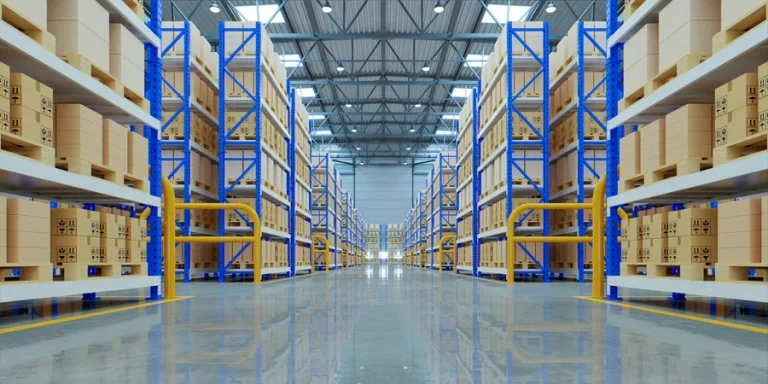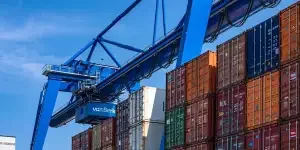What is a Fulfillment Center and How is it Different From a Warehouse?
The terms warehouse and fulfillment center (sometimes referred to as a distribution center or 3PL) are often used interchangeably when discussing logistics and supply chain management, but depending on the circumstances each term can mean something different. At their most basic level, both are large buildings that can hold inventory for all types of businesses that sell physical products whether through an online store such as Shopify, or a brick and mortar retailer. Despite this similarity the services provided and the way they are utilized can be quite different. This guide will describe the functions and purposes of each, helping you better understand which option might be the right for your individual business needs.
A warehouse is cost-effective storage for product inventory
When using the term warehouse, it refers to the place where a company stores products for sellers for an open-ended period of time. It is a large facility or industrial space that houses inventory to be sold. It can contain large containers, shelves, storage bins, and pallets filled with products each identified by their own unique sku (or stock keeping unit), as well as equipment like forklifts that are used to move the inventory around.
The main businesses that work with warehouse providers primarily do wholesale or B2B (business-to-business) orders in large volume. Some ecommerce companies own and operate their own warehouse(s) to store their excess inventory until it is ready to be shipped, while others rent out the warehouse space depending on their storage needs.
Depending on location, renting warehouse space is usually a more cost-effective solution for small to mid-sized sellers for ecommerce fulfillment although that can depend on the available space and rent terms.
Smaller sellers, or those just starting up might decide to lease a space that is smaller and less expensive, such as local storage units if they don’t have the in-house fulfillment space to maintain their inventory. This can help keep the needed products close by their own location in a more cost-effective space.
What is a fulfillment center?
A fulfillment center is the location where the seller or a company the seller hires to outsource their fulfillment, a third-party logistics (3PL) provider, fulfills customer orders placed through an ecommerce store (also known as direct-to-consumer) and/or business-to-retail fulfillment where the seller fulfills wholesale orders to big box retailers. It is often larger in size and scale than a typical warehouse that an individual company might own or rent. The main function of a fulfillment center is to manage the seller’s inventory, store the inventory, ship orders directly to customers and/or retailers, and assist sellers in managing the entire vital, yet often difficult fulfillment operation.
How does a fulfillment center operate?
So many factors go into warehouse management, and because of that smaller details can get overlooked and wind up causing unforeseen problems and supply chain bottlenecks.
A fulfillment center is the hub for all of the logistics processes required to get a seller’s product to their customer. This is also known as the order fulfillment process.
Inventory is stored conveniently in a 3PL’s fulfillment center in preparation to fill customer’s orders. After a customer completes a purchase, inventory is picked from the fulfillment center shelves, packed, and then prepared for shipment.
These business-to-consumer (B2C) orders fulfilled by a 3PL are often shipped directly to an individual home. Fulfillment centers can also be used for B2B orders, often a large volume product that is sent out to larger retailers.
When a seller outsources their fulfillment to a 3PL, the 3PL handles the processes on the seller’s behalf. This can include storage, receiving, packing, and shipping, negotiating lower shipping rates, handle high-volume needs and often lower fulfillment costs other order fulfillment services.
When a seller outsources its fulfillment to a 3PL it can make it easier to manage inventory, save time to allow the seller to focus on more important business tasks, and even improve customer satisfaction.
What are the main differences between fulfillment centers and warehouses?
As stated earlier, while often used interchangeably there are several significant differences between a fulfillment center and a warehouse and the roles each play in the process of getting products to customers.
The main role of a warehouse is simply to store inventory, while a fulfillment center is designed to enhance the customer experience around the process of ordering and having products delivered on time. This is possible because sellers store their inventory in a 3PL fulfillment center located near their customer, helping to reduce shipping time and provide cost savings.
Long-term vs. Short-term Storage
A warehouse is a part of a 3PL’s fulfillment center, where it stores a seller’s inventory, however the main goal of a fulfillment center is to easily manage the processes that happens between the time a customer places an order and the order is delivered to their home or business.
In a best case, inventory will not be in a fulfillment center for longer than 30 days. If inventory needs to be in a fulfillment center longer, this might be considered long-term storage, and most 3PLs will charge a higher warehousing fee. Ideally the seller and 3PL will be in close contact often about inventory levels. It’s important for a seller to maintain an appropriate amount of their products, relative to how often customers are making orders, so that the 3PL fulfillment center has enough product on hand to meet customer demand.
Facility Operations
A warehouse tends to be inactive because it’s used purely for storing inventory. An order fulfillment center is quite the opposite, bustling with activity constantly. A 3PL provides end-to-end order fulfillment solutions and at its fulfillment center including:
- Receiving inventory
- Picking
- Kitting items if necessary
- Packing boxes
- Preparing shipping labels
- Shipping orders
- Managing returns
Operationally in a warehouse, the activity occurs only when inventory is added or sent out. There are rarely any additional services offered.
Frequency of Pickups by Shipping Companies
A 3PL often has established relationships with multiple shipping companies. Since a fulfillment center operates to provide B2B and B2C orders as soon as they are placed, they need multiple companies to pick up shipments at a minimum once a day, sometimes more as needed. This helps to ensure that orders will be delivered in the time frame guaranteed to the customer.
Depending on how a seller chooses to have their products shipped, the shipping carriers might need to pick up any orders with special delivery times such as same-day or next-day at certain times to ensure on-time delivery. Sometimes certain carriers will have a regular time that they schedule pickups, both for domestic and international shipments.
Usually a fulfillment company will have a cutoff time for orders to be placed to the delivery speed chosen by the customer. For example, an order might need to be placed my noon in order to guarantee next-day delivery.
A warehouse, on the other hand, will usually have less frequent pickups scheduled, since it is cost-effective to send out all items at the same time, regardless of the speed requested by the customer.
The freight companies that warehouses use often insist on a certain time to pick up the orders, which can cause a delay in the delivery time and allow for less flexibility in shipping costs for the seller.
Benefits of a 3PL Fulfillment Center
Fulfillment Centers Save Ecommerce Businesses Money
It’s common for fulfillment providers to manage dozens of customers at any given time under one roof. By combining all their customers, they have a lot more buying power with their vendors. From materials, including the shipping boxes, to packing materials, also known as dunnage, the fulfillment company can leverage the combined volume to get heavy discounts which they can pass along to their customers. Not to mention, the seller doesn’t need to incur the cost of managing and staffing their own fulfillment center.
The single largest fulfillment expense for a seller is shipping, which can be as much as 70% of the overall fulfillment costs. Larger, more experienced fulfillment companies broker deals with shipping carriers, like FedEx, UPS, and DHL, to get group discounts – again, these discounts are passed down to the sellers.
Outsource Inventory Storage and Management
If a seller is not a huge company shipping thousands of items a day, the hassle of managing a warehouse may be more expensive and time consuming than it is worth. Allowing a fulfillment center to handle these tasks can be much more efficient. A good indicator that it might be time to utilize a fulfillment center is when a seller can no longer keep up with managing the flow of orders incoming and being able to ship them out on time.
Allowing the Seller to Focus on the Big Picture
While taking orders, picking out products, packing boxes, and shipping are critical components a product company’s bottom line, these tasks can also be easily outsourced to an experienced 3PL. For a growing online business, giving these tasks over to an expert (the 3PL) means more time can be spent on business operations like customer service, marketing, and strategic planning.
Ecommerce Fulfillment Services
With more customer buying habits shifting from brick and mortar stores to online, its imperative sellers work with an experienced a fulfillment company that has the technology and operational expertise to manage their sellers’ ecommerce fulfillment. From connecting to the sellers ecommerce platform, like Shopify or BigCommerce, to having the operational processes in place to fulfill hundreds, possibly thousands, of ecommerce orders every day.
These fulfillment company should be able to scale quickly with the growing demands of the sellers’ ecommerce business. Often times, the ecommerce businesses see large spikes in sales in a short periods of time due to seasonality and various promotions throughout the year. Fulfillment companies should have the adequate space and be able to flex their labor to meet the sellers’ needs without sacrificing service or quality.
You Don’t Need to Own a Warehouse
If your company has a successful product, and your are rapidly growing your inventory to meet customer needs, you know the feeling of overflowing inventory, whether it’s in your home garage, office, storage space, or elsewhere. It’s an excellent problem to have, but strategizing solutions can be a huge hassle.
When you choose to outsource to an order fulfillment company, the 3PL can store all of your inventory for you without you having to take deliveries, handle the products, organize and sort everything. This leaves more space that might be needed for business operations (or your sanity!). It can also be a cost-effective method to help boost your bottom line.
The 3PL will help you manage the flow of inventory from manufacturer to their fulfillment centers; they will alert you when the inventory levels get below a certain threshold and order more inventory to be sent to their fulfillment centers which will decrease your fulfillment costs.
Distributed Inventory
One of the biggest factors in choosing a 3PL is finding out the location of their fulfillment centers and if they are close to the majority of your customers.
Ideally the less distance your product travels, the quicker it gets delivered to your customer and the less money you’ll pay for shipping.
Today’s customers expect convenience and speed when making online purchases. Having your product stored, ready to be picked and shipped, close to the majority of your customers (or near major metro areas that can reach large volumes of customers quickly), will help ensure shoppers get their orders in the shortest amount of time possible.
Leveraging Expertise and Specialization
Managing logistics can be frustrating and challenging for any seller. It adds an extra layer on top of all the other business operations that need to be handled. A 3PL fulfillment center can handle the complex processes and all moving parts involved, with ease and efficiency. From order processing, inventory management, packing and shipping, fulfillment companies have been handling these tasks for years. They have the best technology and relationships to get products to customers (or businesses) quickly and cheaply. In the long run, outsourcing fulfillment and logistics to an experienced 3PL is very cost-effective for the seller.
“It’s been helpful to have a partner who can handle the warehouse and logistics side of our business for us. I think the team is very knowledgeable. They bring experience fulfilling to different retailers that has made this a very steady area of our supply chain, from launch until now.”
– Jim Thome
Head of Operations, Rylo
Automate the Fulfillment Process
Modern 3PL fulfillment companies utilize the latest technology for their operations. This allows every step of the fulfillment process to be captured and documented in real time. Each customer order is automatically sent from the ecommerce shopping cart to a fulfillment center to get picked, packed, and shipped. And once the order is shipped, tracking information can be sent back to the seller as well as the customer to ensure that all goes properly.
By having logistics management software a 3PL can track and collect data on a seller’s inventory through the year. This information can be helpful to predict business, or benchmark growth.
Often a 3PL also has the technology infrastructure to share their digital tools with sellers. DCL, for example, has a mobile app called eFactory, in which sellers can see the status of their inventory, monitor orders, and get updates more easily, and at their convenience. Being a small business owner is a 24/7 job, and being able to check on shipping costs, fulfillment and inventory from a smartphone is so helpful.
Value Added Services
While the primary focus of a seller when working with a fulfillment center is to pick, pack, and ship their orders, sellers can leverage their fulfillment partner for other related services, often referred to as value added services. Value added services include things like kitting, assembly, and returns manage (or reverse logistics). Having a these services available at your fingertips is invaluable as sellers can quickly adapt their customers’ needs and market trends.
Here are some examples of projects that would fall under value added services:
- Custom packaging and labeling
- Assembling products to create a new SKU
- Branded tape and marketing inserts
- Lite testing of products (electronics)
- Returns management and automation
What About Amazon Fulfillment Centers?
FBA is a service where Amazon manages your inventory at their fulfillment centers and will pick, pack, and ship orders to your customers. The seller is responsible for the associated fees, including storage and fulfillment fees.
Pros
By using FBA, sellers leverage Amazon’s world class operation and large fulfillment center network. The seller doesn’t have to worry about managing their own warehouse and fulfilling their own orders, allowing them to focus on running other facets of their business.
FBA gives sellers the option to offer free, one or two-day shipping to Prime Members. This is a huge draw to sellers as it gives them the best chance of winning the buy box with prime members.
Cons
While having massive scale and operational expertise is one of Amazon’s biggest advantages, it can also be one of their biggest weaknesses in terms of flexibility and cost for sellers.
According to Amazon, the company now operates 75 fulfillment centers and employs 125,000 full-time employees in the US. They are spending billions of dollars a year to run these fulfillment centers and these costs are passed down to the sellers. Amazon’s ever-changing fulfillment and storage fees for FBA sellers is well documented and can be pain point for sellers as these costs eat into their profits.
Like most businesses these days, sellers have to be nimble in order to keep up with customer demands and industry trends. Once your product is shipped to Amazon to be stored and fulfilled, your flexibility becomes a lot more limited. Sellers’ products are tied up at Amazon centers making it challenging to sell via other channels. In addition, sellers can no longer make changes to the packaging, add new inserts, or do any other custom kitting. This can be a deal breaker for a lot of sellers, especially high growth brands.
Bottom Line
While the terms warehouse and fulfillment center are frequently used interchangeably, the need for a simple warehouse space is much different than being able to utilize complete fulfillment services via a fulfillment center.
What works best for any individual seller comes down to the type of service they need. A warehousing service that only stores inventory could prove valuable if longer terms storage is needed, or the company is still operating some of the fulfillment in-house. Alternatively, if a seller is needing fast turn around for large orders, working with a 3PL to handle the fulfillment, customer service, shipping and end-to-end logistics, is probably the best option to help grow that seller’s business. A trusted fulfillment partner can help with all of these issues.
Source from DCL Logistics
Disclaimer: The information set forth above is provided by dclcorp.com independently of Alibaba.com. Alibaba.com makes no representation and warranties as to the quality and reliability of the seller and products.




